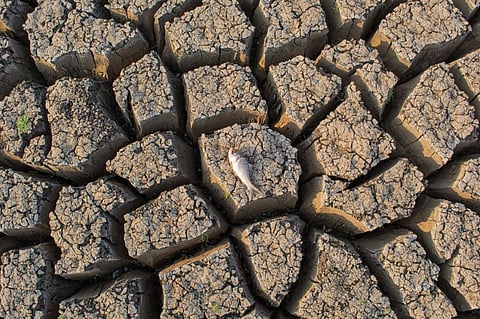

At least 13 east-flowing rivers between Mahanadi and Pennar have no water at the moment, according to an analysis of data released by the Central Water Commission (CWC). They include Rushikulya, Bahuda, Vamsadhara, Nagavali, Sarada, Varaha, Tandava, Eluru, Gundlakamma, Tammileru, Musi, Paleru and Munneru.
Flowing through the states of Andhra Pradesh, Telangana and Odisha through an area of 86,643 square kilometre (sq km), the rivers drain directly into the Bay of Bengal. Agricultural land in this basin is around 60 per cent of the total area and this situation even before the peak of summer is alarming.
The important urban centers in the combined basin include Visakhapatnam, Vizianagaram, East Godavari, West Godavari, Srikakulam and Kakinada.
The storage in the basin has been on a continuous decline this year, according to the data released by CWC. It was 0.062 billion cubic metre (BCM) on February 22, 0.043 BCM on February 29, 0.024 BCM on March 7, 0.005 BCM on March 14 and zero on March 21. In CWC’s weekly bulletin on March 28, the basin again had no storage.
During this time last year, the storage was 32.28 per cent of the capacity of the basin.
Andhra Pradesh and Telangana have experienced ‘large deficit’ (65 and 67 per cent respectively) in rainfall since March 1, according to the India Meteorological Data (IMD).
The river systems in India provide water for irrigation, drinking and domestic consumption as well as cheap transportation and electricity. Water shortage in the river basins gravely affect the socio-economic conditions, livelihoods and agricultural activity of the regions, which is dependent on the rivers for water supply.
Source: Central Water Commission
But a majority of the basins recorded less than 40 per cent of their live storage capacity. Out of the 20 river basins, for which data is available with the CWC, water storage in at least 12 was less when compared to the last year.
Cauvery, Pennar and east-flowing rivers between Pennar and Kanniyakumari were also the worst affected, having deficient or highly deficient water storage.
Meanwhile, the Ganga basin, which is the largest basin in the country, recorded water storage at less than half (41.2 per cent) of its total capacity. This is also lower than the corresponding period last year.
Around 286,000 villages in 11 states are located on the Ganga basin where water availability has been on a decline. This is concerning as agricultural land accounts to 65.57 per cent of the total basin area.
Narmada, Tapi, Godavari, Mahanadi and Sabarmati river basins recorded 46.2 per cent, 56 per cent, 34.76 per cent, 49.53 per cent and 39.54 per cent storage relative to their capacities, respectively.
In all of the above, including Ganga, the storage position is considered either ‘better than normal’ or ‘normal’, as per CWC, based on the average of last five years.
However, several areas within the boundaries of the river basins have been experiencing ‘extreme’ to ‘exceptional’ drought, noted India Drought Monitor, operated by IIT Gandhinagar.
Observed drought condition as of March 27, 2024
The river basin map shows that many areas in the basins of Ganga, Brahmaputra, Indus, Cauvery, are facing different degrees of drought. Source: India Drought Monitor, IIT Gandhinagar
Overall, at least 35.2 per cent area in the country is under ‘abnormal’ to ‘exceptional’ degrees of drought currently, according to the monitor. What is worrying is that out of this, 7.8 per cent area is under ‘extreme’ drought conditions and 3.8 per cent is under ‘exceptional’ drought. A year ago, this was 6.5 per cent and 3.4 per cent respectively.
States like Karnataka and Telangana have been grappling with drought and drought-like conditions because of rainfall deficits, which also left the country’s major reservoirs dry.
The live storage capacity in India’s 150 major reservoirs has dropped to 36 per cent of their total capacity, with at least six reservoirs recording no water storage.
There are at least 86 reservoirs in which the storage is either 40 per cent or below. Most of these are in the southern states and in Maharashtra and Gujarat, according to CWC’s weekly bulletin released on March 28.